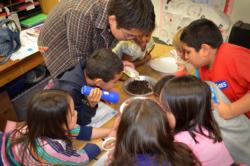
Teenagers-as-Teachers
Teenagers as Teachers

Benefits of Teen Teachers
A promising approach to support positive youth development is having adolescents serve as teachers for younger children. Adolescents grow in their competence, confidence, connection, caring, character, and contribution.
Worker, S. M., Iaccopucci, A. M., Bird, M., Horowitz, M. Promoting positive youth development through teenagers-as-teachers programs. Journal of Adolescent Research. http://journals.sagepub.com/doi/abs/10.1177/0743558418764089
Twelve Essential Elements
In the book “Teenagers as Teachers” there are 12 essential elements needed to successfully work with teenagers.
- Teenagers as Teachers:Teenagers can be extremely effective teachers of young children.
- An Effective Program Director: The most prominent common element among successful programs in which teenagers taught younger youth was a passionate, committed adult program director.
- Teen Recruitment and Selection: Recruiting and carefully selecting a team of teenagers is an important process in developing the teens and teachers program.
- Curriculum: A strong curriculum with a series of detailed lessons to teach the children is essential to developing strong, confident teen teachers.
- Attention to Details: A well-coordinated and functioning program depends on attending to a myriad of essential details.
- Initial Training: Teenagers must gain a deeper understanding of the subject matter that the level at which they will be teaching the children.
- Ongoing Training and Support: Even programs that provide comprehensive high-quality initial training offer ongoing training to the teen teachers.
- Team Building: Encouraging teamwork capitalizes on the desire of many teenagers to draw support from peers.
- Preparing Teens for Success: In addition to providing high-quality initial and ongoing training, they take active steps to ensure that teenagers will experience success as teachers.
- Recognition and Reward: The need for recognition is universal and a vital part of programs with teenagers as teachers.
- Teen Voice and Involvement: Effective cross-age teaching programs not only provide opportunities for teenagers to teach but also to have a voice in program planning.
- Monitoring and Evaluation: Essential to the development of effective and confident teenagers are opportunities to receive feedback coupled with adequate time for reflection about their experiences.
Lee, Faye C. H., et al. Teenagers as Teachers: Twelve Essential Elements. University of California, Agriculture & Natural Resources, 2002.
Other Resources
Youth Teaching SCIENCE in afterschool
Smith, M.H., & Enfield, R.P. (2002). Training 4-H teen facilitators in inquiry-based science methods: The evaluation of a “step-up” incremental training model. Journal of Extension, 40(6). Available from http://www.joe.org/joe/2002december/a3.php [Animal Ambassadors curriculum]
Bird, M., & Carver, R. (2002, April). Youth experiences in science project evaluation. University of California Cooperative Extension 4-H. Retrieved from http://cesacramento.ucanr.edu/files/24586.pdf
Ponzio, R.C., Junge, S.K., Smith, M.H., Manglallan, S.S., Peterson, K.D. (2000). 4-H teens as science teachers of children. In M.T. Braverman, R.M. Carlos, & S.M. Stanley (Eds.), Advances in Youth Development Programming: Reviews and Case Studies from the University of California (pp. 75-91). Oakland, CA: Division of Agriculture and Natural Resources.
Jorgensen, E.L. (2000). Project excel: Cross-age science teaching as a community intervention. In M.T. Braverman, R.M. Carlos, & S.M. Stanley (Eds.), Advances in Youth Development Programming: Reviews and Case Studies from the University of California (pp. 107-125). Oakland, CA: Division of Agriculture and Natural Resources.
Ponzio, R.C., Peterson, K.D. (1999). Adolescents as effective instructors of child science: Participant perceptions. Journal of Research and Development in Education, 33(1), 36-46.
Ponzio, R., & Fisher, C. (Eds.). (1998). The joy of sciencing: A hands-on approach to developing science literacy and teen leadership through cross-age teaching and community action. San Francisco, CA: Caddo Gap Press.
Ponzio, R., & Peterson, K. (1997). Adolescents as effective teachers of child science. Paper presented at the annual meeting of the Northern Rocky Mountain Educational Research Association, October, Jackson Hole, CO.
Ponzio, R., Fisher, C. (1995). Introducing prospective teachers to contemporary views of teaching and learning science: The science and youth project. In M.J. O’Hair & S.J. Odell (Eds.), Education Teachers for Leadership and Change: Teacher Education Yearbook III (pp. 257-284). Thousand Oaks, CA: Corwin Press, Inc.
Teens as counselors in CAMPS
Bird, M. & Subramaniam, A. (2011). Teens as teachers enhance environmental education and personal skills through service learning. In A. Subramaniam, K. Heck, R. Carlos, & S. Junge (Eds.), Advances in Youth Development: Research and Evaluation from the University of California Cooperative Extension (2001 - 2010) (pp. 32-41). Davis, CA: Division of Agriculture and Natural Resources. Retrieved from http://4h.ucanr.edu/files/130750.pdf